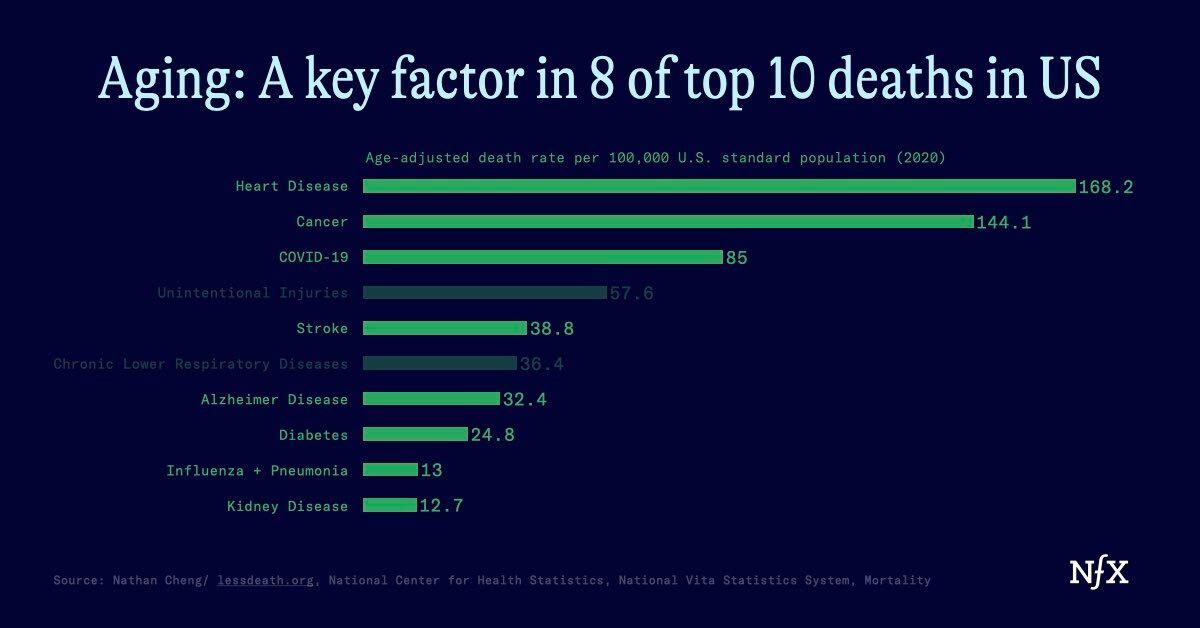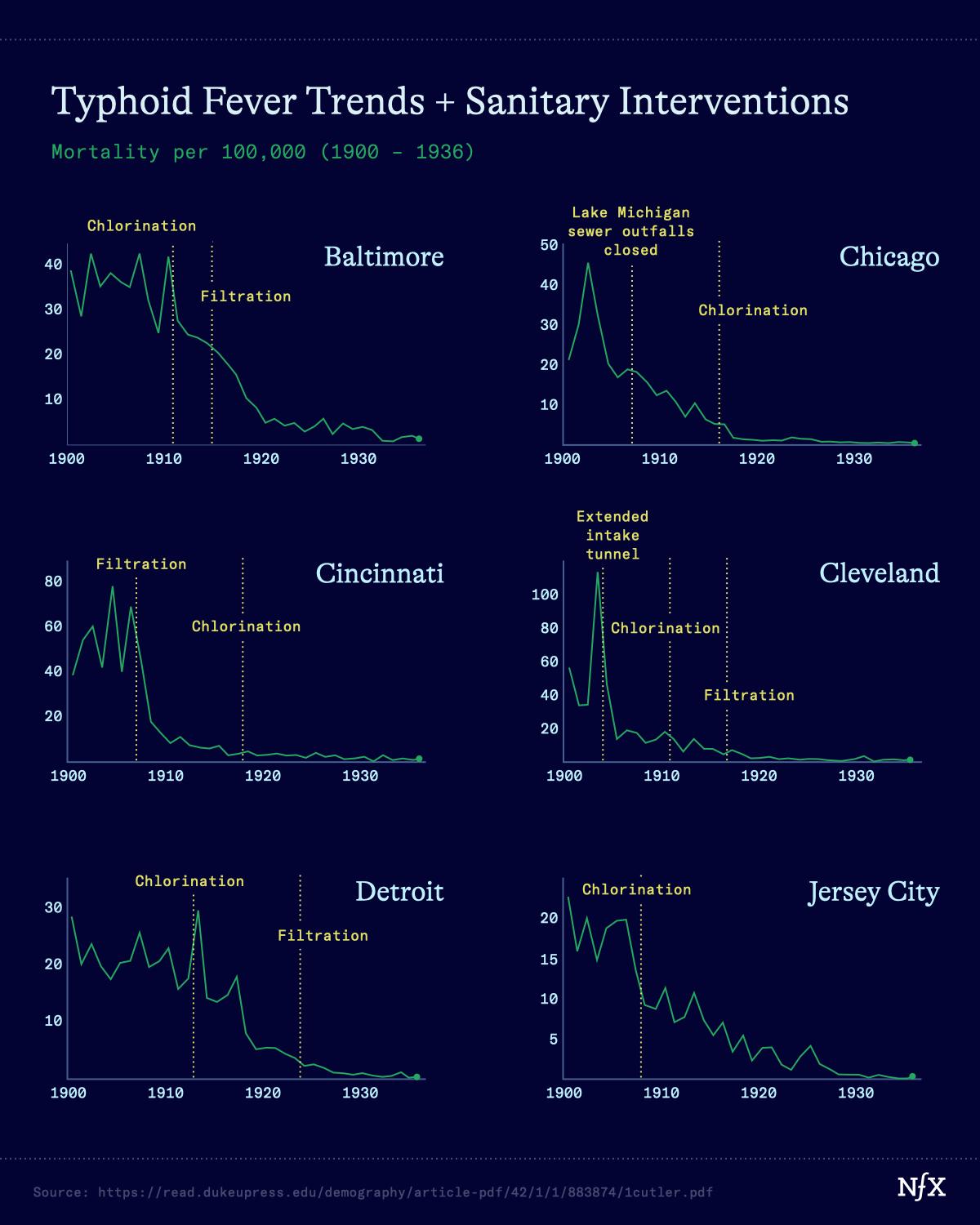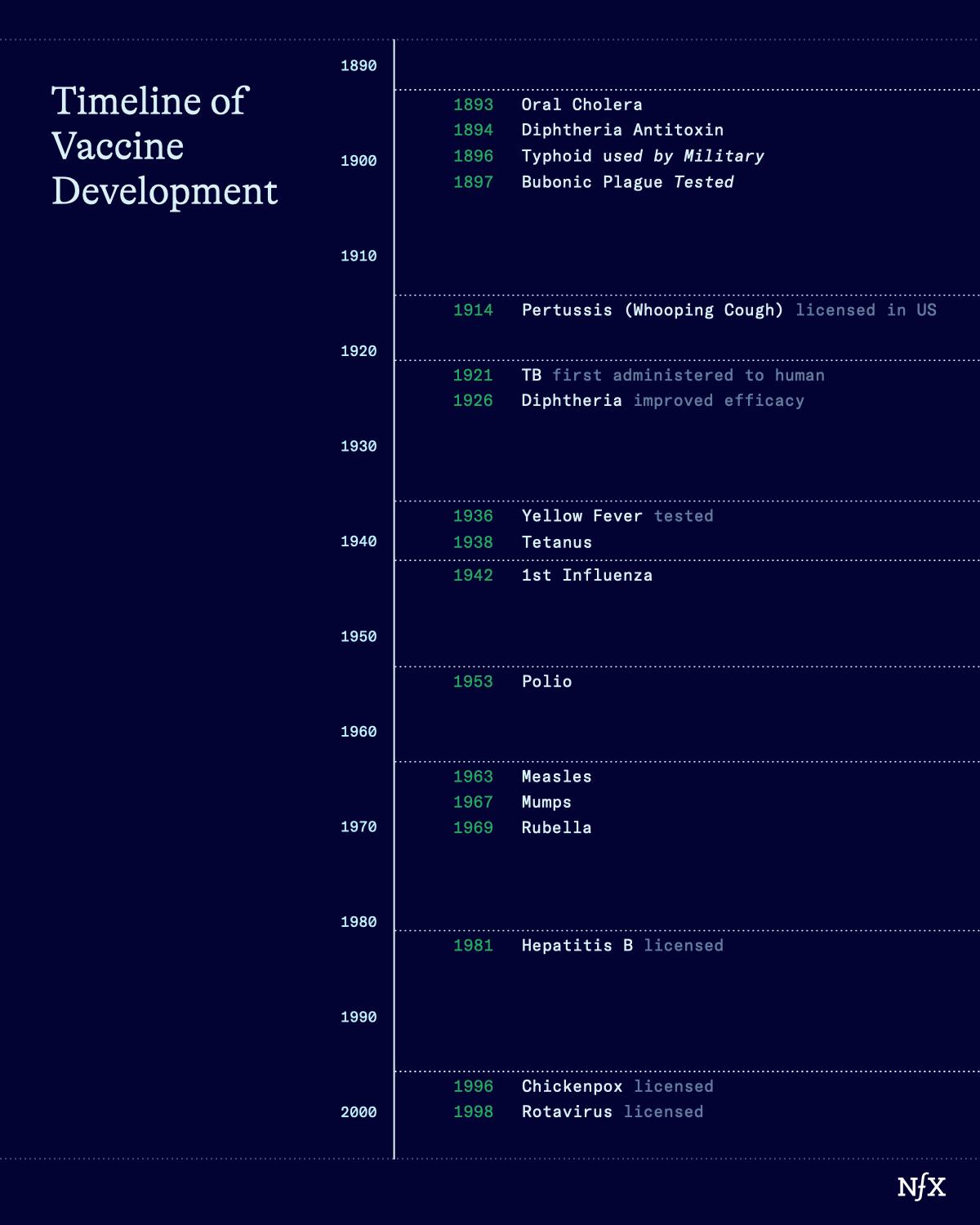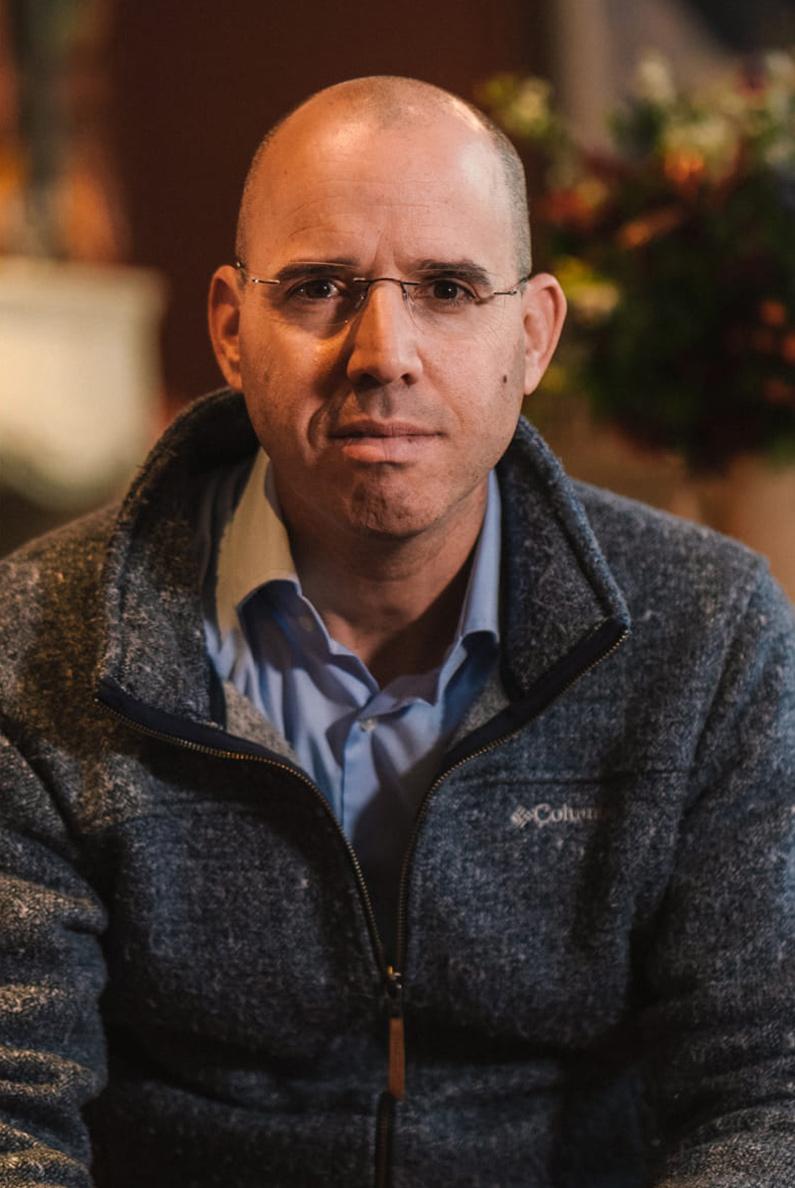

The best form of healthcare is never getting sick in the first place.
When we think of longevity, we think of it as a transition from sick-care to healthcare. Today, we want to explain what we mean when we say healthcare: real healthcare is a new wave of preventative medicine that keeps healthy people healthy.
Aging is a major risk factor for many of the chronic diseases that cause the most suffering today – like heart disease, Alzheimer’s and cancer. If we want to prevent those conditions, we need to think about staying healthier for longer. The simplest way to stay healthy: keeping the body young.
Over the course of history, we’ve seen preventative medicine (medicine for healthy people) save millions of lives. Basic sanitation stopped the spread of cholera. Vaccines prevented life threatening infections.
Longevity companies have the potential to have a huge impact – the same impact that vaccines or sanitation had in the last 200 years. We may be able to prevent many of the aging-related processes that set diseases in motion.


Imagine what it would be like to feel like a 25-year-old, even when you’re 90. You would have a young, strong immune system that prevents infections before you get sick. You don’t lose your hair, or develop joint pain. Your risk of cancer is low. Your heart is healthy.
That’s the world that longevity technologies can create – and those technologies have massive scientific and economic momentum, right now.
The History of Medicine for Healthy People
For most of human history, the leading causes of death and disease were infectious diseases. Over the course of the late 19th and 20th century, we slowly became better at not just treating, but preventing, those diseases with technology.
We began with very basic technologies, like sanitation and water treatment. As science has advanced, we’ve developed more complex preventative technologies, like vaccines. Finally, we developed additional tools that helped us identify risk and intervene earlier and earlier in very complex diseases – like screenings for cancer.
The main hallmark of real preventative technologies is that it’s something that everyone can use to stay healthy. Everyone should have clean water, or a vaccine that prevents a deadly disease. These are the biggest possible markets because they include everyone.
There have been 3 previous waves of these technologies before, and we’re on the verge of a 4th.
Wave 1: Basic Sanitation
After the industrial revolution, cities were plagued by diseases like cholera, typhoid fever, tuberculosis and smallpox. In the 1800s, one out of every 13 people in London died of smallpox. When cholera swept through New York between the 1830s-1860s, one in every 20 people died from cholera.
Understanding of germ theory was limited. Instead, people used the “technologies” available at the time to prevent illness: basic sanitation, public health workers, and water treatment.
In New York, a newly formed Metropolitan Board of Health dispatched teams of sanitary inspectors to disinfect the homes of cholera patients. It was a blunt tool – but it worked. During New York’s 1866 cholera outbreak, one tenth of the amount of people died compared to previous cholera outbreaks.
Soon, we saw the development of water treatment technologies like sand filtration, mechanical water filtration, and water chlorination. Those technologies reduced deaths even more. By some estimates, clean water was responsible for nearly half the mortality reduction seen in major cities in the late 19th and early 20th century.
Basic sanitation and water filtration were one of the first waves of public technologies that were used by everyone (or most people) to keep them healthy. They were simple, but effective. As we gained more complex understandings of diseases, those technologies became even more powerful.


Wave 2: Vaccines
Once we understood the role microorganisms played in disease, we leveraged that knowledge to develop vaccines and antitoxins at a rapid pace.
You can see just how fast this idea took hold. In 1877 Louis Pasteur proved that anthrax was caused by bacteria. By the 1880s, he had developed an immunization against anthrax for animals using the live, attenuated virus method.
The concept of vaccination had existed for nearly a century before Pasteur, but it truly found its fit in the late 1890s, when the pace of discovery and the scale of deployment took off at the same time.
From then on out, a new vaccine was developed against a major disease nearly once per decade:


Each year, these vaccines continue to save lives. It’s estimated that in a single birth cohort in the US, vaccination prevents 20 million cases of disease, and about 40,000 deaths.
This story isn’t over. Not by a long shot. We see a new generation of vaccines coming that is likely to have just as big an impact.
Wave 3: Screening
By the late 20th century, vaccines had already done a great job of containing many infectious diseases. But chronic diseases like heart disease, or extremely complex diseases, like cancer, were the new pressing threats.
Screening technologies have allowed us to identify these diseases as early as possible. If total prevention wasn’t feasible, we aimed to intervene earlier and earlier.
In the 1970s, coronary arteriography became a viable branch of cardiology, and a way to evaluate heart health. We also have embraced cancer screenings as routine forms of healthcare.
The pap smear was first developed in 1923, but wasn’t promoted by the American Medical Society Until 1960. (Cervical cancer rates have declined by 50 percent since that screening method was adopted.)
It’s a similar story for mammography. Mammography had existed in various forms, but the technology advanced during the course of the 1960s and 70s and was officially endorsed by the American Cancer Society in 1976.
This wave is still happening. We still don’t have screening protocols for many types of cancers, or other diseases. We’re still developing screening technologies that allow us to better track these conditions.
For example, companies like Prenuvo are developing the next generation of MRI screening protocols to make the field cheaper, and more accurate. They’re working toward a program of whole body MRI that can identify over 500 conditions, so we can intervene early.
Companies like Grail are pushing this wave of technology forward as well. Grail has developed a simple blood test that can search for signs of methylation in cell-free DNA associated with various cancers –including those without well-established screening protocols.
The defining characteristic of this new cohort of screening companies is the emphasis on both technology and biology. The tools of techbio have made this screening wave more powerful, faster, and less invasive. For example, NFX portfolio company C2i Genomics’ cancer surveillance platform is able to detect residual cancer in a patients’ blood tests with rapid turnaround times. It’s a huge step forward from the screening and surveillance methods we’ve been using for decades.
Imagine detecting cancer early, far before it has the chance to grow. Or, being able to predict if cancer will develop in the future, and deploying preventative treatments. This is all coming.
The Fourth Wave of Medicine For Healthy People
The first two waves of preventative medicine tackled infectious disease via sanitation and vaccines. The third tackled complex or chronic diseases through surveillance and screening. Today we are entering a fourth wave of preventative medicine fueled by the understanding that aging is the major risk factor for today’s most devastating diseases.
The underlying mechanisms are more complex than any problem we’ve ever tackled before, but we’ve never been closer to untangling them with the tools of techbio.
Here’s where we see momentum.
1. The Future of Vaccines
We’ve already covered how transformative vaccines were in the 20th century. But since then, there had been fairly few large scale advancements in vaccine technology until the development of mRNA vaccines to fight COVID-19.
The next wave of healthcare will include a major revolution in vaccine technology beyond mRNA vaccines. There’s still room to develop vaccines that are as dynamic as the infections they aim to prevent.
The major unsolved problem in today’s vaccine landscape is constant mutation. In biology, what doesn’t kill you mutates and tries again. But vaccines that we currently rely on are developed against diseases that aren’t constantly mutating.
The next wave of vaccination technology will be able to match the speed of evolution. There will be different ways of reaching this goal. A vaccine platform approach – which is used by many mRNA vaccine manufacturers – is a step that already allows us to design new vaccines faster than ever.
NFX portfolio company Centivax is creating universal vaccines – vaccines that can protect against every past and future version of a disease. They’re doing this by developing a vaccine that causes the body to produce broadly neutralizing antibodies, trained on signatures of these pathogens that don’t change from generation to generation.
In short, the next wave of healthcare will move us to a more dynamic approach to vaccination – one that doesn’t require us to reinvent the wheel each time.
Imagine a future without viruses. No COVID. No flu. That’s millions of lives saved, and so much suffering prevented. With the next generation of vaccines, that is within reach.
2. The Benefits of Healthy Living for Everyone (GLP-1 Drugs + Beyond)
Some people are able to sleep for 8 hours every night, go to the gym every day, eat healthy meals all day and meditate when they’re stressed. That’s a life we should all strive for, but it’s not a reality for most people. That shouldn’t mean they pay the price in their health later on.
Drugs like GLP-1 agonists are showing us that we can give people far more help in achieving their health goals than previously thought.
The traditional prescription for obesity, for example, has always been based on lifestyle interventions. Exercise more. Eat less. Sleep well. Be less stressed. But these don’t always work for everyone, despite their best efforts. And there may be more factors at play, like genetics and changes within the body, that prevent people from losing weight even if they do follow the perfect diet and exercise plan.
In combination with diet, exercise and healthy living, these drugs have allowed us to treat obesity like a medical condition. For those who would benefit from losing weight, GLP-1 drugs (Wegovy, Ozempic and many others in the pipeline) help them do it.
As a result, these drugs open up the massive benefits of healthy living to more people. They don’t have to worry about increasing their risk of heart disease or pregnancy complications linked to weight just because their diet plan isn’t working fast enough, or they can only exercise for a certain amount of time per day.
Naturally, these drugs are part of a nuanced conversation that will evolve over time. But for now, they’re revealing an opportunity.
We need to make the benefits of a healthy lifestyle broadly accessible.
We see two major areas of opportunity here. The first, is that there’s room to improve upon existing GLP-1 drugs – which are difficult to manufacture and need to be taken for life. There are other drugs that may work better. Oral versions that may be easier for people to tolerate. And newer, more programmable modalities under investigation. For example: NFX portfolio company Eleven Therapeutics is developing RNA-based GLP-1 drugs.
We will likely see a variety of approaches develop soon.
Second, we can think about the bigger picture behind drugs like these. These drugs, when combined with healthy habits, help us achieve our health goals, even when life gets in the way.
That perspective allows us to ask bigger questions: How can we make the anti-aging effects of sleep on the brain stronger? How can we augment the biochemical effects of exercise?
We’re already seeing companies apply this style of thinking. For example, BioAge Labs is developing a drug that harnesses a peptide released during exercise to prevent muscle loss.
Imagine a future where no one struggles with weight loss or develops the metabolic conditions that are linked to obesity. Or where you don’t have to worry about missing out on the benefits of exercise because you can only find 10 minutes to work out.
We can dig into the defensible magic behind lifestyle interventions. The benefits of healthy living should be for everyone.
3. Cellular Rejuvenation Technology
Aging is an information problem. Eventually, the biological code that keeps our bodies young begins to make errors. We need to have a backup.
We’re excited about the potential for regenerative technologies to create true “software updates” for the human body. That could be the technology that allows us to regrow organs for transplantation, or create backups of cells of limited supply that disappear over time (stem cells or egg cells, for example), or reset the biological clocks within aging cells.
One area that’s especially interesting in this field is partial reprogramming.
We know that we can coax cells backwards in time. For example, we’ve shown that we can use epigenetic programming methods to transition differentiated cells back to pluripotent states via Yamanaka factors. While that process resets markers of aging, the transition back to pluripotency creates complications. It has been linked to cancer in mouse models, and isn’t a compelling candidate for treatments in-vivo.
However, we are learning that there are ways to rejuvenate cells without inducing pluripotency or causing cancer. Partial reprogramming is a matter of de-aging cells without de-differentiating them by creating the correct epigenetic cocktail.
We’ve seen companies embrace this challenge and gain exciting traction.
- NewLimit is developing a discovery engine that helps discover reprogramming factors that can transition old cells to young cells, and improve function.
- Turn Bio is approaching reprogramming from an mRNA perspective, looking to use that approach to revitalize older cells to fight off disease.
- Retro (backed by Sam Altman) and Altos labs (backed by Jeff Bezos and Yuri Milner) have raised $180M and $3B respectively to pursue this space too.
- NFX-backed Renewal Bio is able to create Stembriods: stem cell derived embryo models (no sperm, no egg, no uterus) starting by reprogramming somatic cells. They can then use those young, genetically identical Stembriod-derived cells to renew and repair the body.
This technology will turn aging into a choice, not an inevitability. Imagine never having to lose your hair. Imagine removing the stress of having to have children before a certain age. Imagine not having to worry about getting sick as your immune system ages.
The Opportunity for TechBio Startups
When we look at Techbio companies, we’re looking for companies that can tackle huge markets. Longevity/Health Care companies are the biggest, because they’re for everyone.
We’ve seen how big these companies and medicines can be. Basic sanitation transformed cityscapes. Vaccines became routine aspects of healthcare. After a certain age, everyone does regular cancer screening. This is medicine for everyone, that becomes integrated into regular life.
We’re excited to invest in the next chapter in this story: New companies, powered by techbio, with the goal of keeping healthy people healthy.
It’s a huge moment for scientist-Founders with the right defensible magic, the right team, and the right guidance.
If you’re a scientist founder ready to prevent, rather than just treat, major diseases, come talk to us.
As Founders ourselves, we respect your time. That’s why we built BriefLink, a new software tool that minimizes the upfront time of getting the VC meeting. Simply tell us about your company in 9 easy questions, and you’ll hear from us if it’s a fit.

